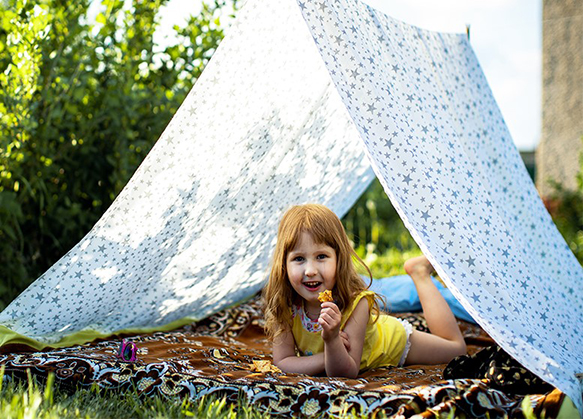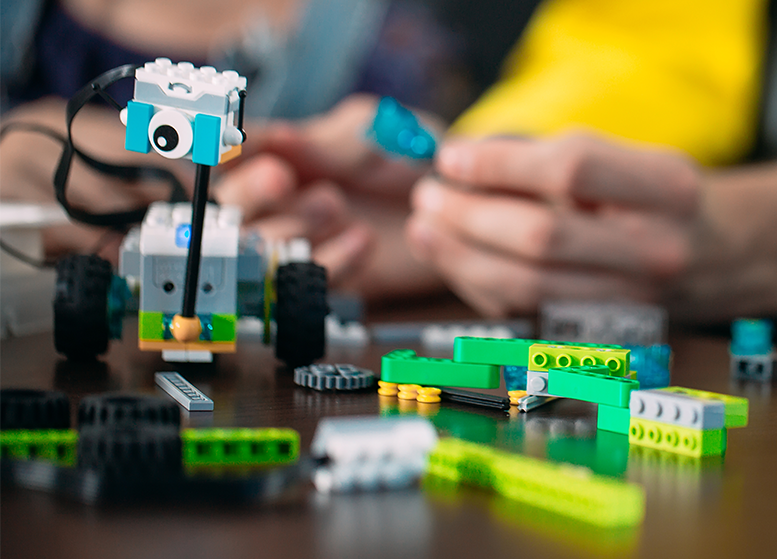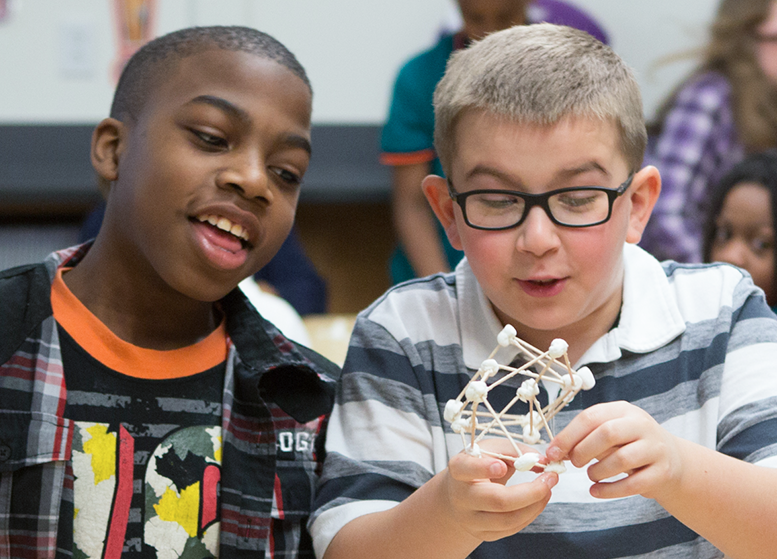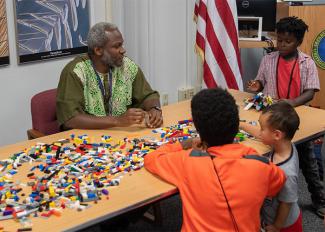As NETL turns its attention to inspiring the next generation of energy researchers this month, the Lab is presenting four fun and engaging engineering activities that parents can enjoy with their children. These classic educational experiences will help build critical thinking skills that can spur an early interest in science, technology, engineering and math.
 Build a childhood memory! This is fun activity for both parents and children that also helps with learning about engineering through play. Is this a fort that can fit the whole family? Is this a jungle hideout or a mad scientist’s lair?
Build a childhood memory! This is fun activity for both parents and children that also helps with learning about engineering through play. Is this a fort that can fit the whole family? Is this a jungle hideout or a mad scientist’s lair?
Suggested supplies:
- Various attaching tools like clamps, chip clips, clothes pins, binder clips and rubber bands.
- Fitted sheets, flat sheets and light-weight blankets.
- Support items like ropes and books.
- Furniture supports like chairs, card tables and couch cushions.
Directions:
- Stake out your territory, gather your supplies and turn on your imagination.
- Look around your environment as the furniture becomes the walls of your fort. For example, try setting four chairs in a square and topping them with a fitted sheet or draping flat sheets over a card table.
- Explore other geometric designs and angled roofs by using line supports that are tied or clamped to furniture or stairs with books to hold down the edges.
- For more advanced engineers, try using various lengths of half-inch PVC pipe joined with connectors to create your frames. Let the children either wing it and see what works or sketch out their design ahead of time.
 Most parents remember receiving their first set of connectable building bricks as a child and the hours of fun they provided. As these toys now incorporate various connectors and movable parts, they can be used to explore many engineering concepts.
Most parents remember receiving their first set of connectable building bricks as a child and the hours of fun they provided. As these toys now incorporate various connectors and movable parts, they can be used to explore many engineering concepts.
Suggested supplies:
- Building bricks.
- Small pieces of candy.
- Water.
Directions:
- Try replicating waterways, complete with dams and bridges, by building up from a base plate.
- Add a little bit of water to brings your creation to life as you see how the different structures change the flow of the water.
- Build mini catapults to send small pieces of candy flying.
- Kids can adjust the length of the lever and height and position of the fulcrum to explore basic concepts in physics.
 Physics and creative thinking collide in this classic activity that challenges children to protect a fragile egg as it plummets from a predetermined height. The sky’s the limit for adjusting the difficulty of the challenge, as a parent can put limits on size and weight or drop the package from increasing heights. Parents should always remember safety when it’s time for the big drop. Kids can try using more than one approach and then compare the results afterward to get a real feel for scientific experimentation.
Physics and creative thinking collide in this classic activity that challenges children to protect a fragile egg as it plummets from a predetermined height. The sky’s the limit for adjusting the difficulty of the challenge, as a parent can put limits on size and weight or drop the package from increasing heights. Parents should always remember safety when it’s time for the big drop. Kids can try using more than one approach and then compare the results afterward to get a real feel for scientific experimentation.
Suggested supplies:
- Egg(s).
- Tape measurer (or a string and ruler).
- A sturdy package, such as a box, peanut butter jar or other food container.
- Plastic wrap, socks, bubble wrap, or recycled materials for packing the egg.
Directions:
- Pick a safe location for the egg drop and measure the distance to the ground using a tape measure (or use string and then measure the string with a ruler).
- Protect your egg! Experiment by using different vessels and packing materials.
- We recommend using plastic wrap around anything made of fabric indoors.
- Drop the protected egg.
- Unpack and check the state of the egg.
- Questions to consider:
- Why did the egg survive or not survive the impact?
- If it remained intact, can you drop the egg from a higher distance?
- If it broke, would a different protective vessel help?
 Every brilliant bridge builder likely got their engineering spark from some sort of hands-on activity in their childhood. A quick way to provide a taste of trigonometry is to try building a structure using toothpicks and candy gumdrops. By exploring different shapes, children can compare the strength of structures made with triangles compared to squares. Once the kids succeed, they can compare their creations to real-life structural supports and see if there are geometrical similarities.
Every brilliant bridge builder likely got their engineering spark from some sort of hands-on activity in their childhood. A quick way to provide a taste of trigonometry is to try building a structure using toothpicks and candy gumdrops. By exploring different shapes, children can compare the strength of structures made with triangles compared to squares. Once the kids succeed, they can compare their creations to real-life structural supports and see if there are geometrical similarities.
Suggested supplies:
- Gummy candy or marshmallows.
- Toothpicks.
- Optional: spaghetti noodles and books (the heavier the more difficult the activity).
Instructions:
- Start with simple geometry, such as a triangle of 3 gumdrops and 3 toothpicks. Then add more toothpicks and gumdrops to turn the triangle into a pyramid that can stand on its own.
- Build a square with 4 gumdrops and then make it into a cube!
- With your basic geometric components in place, build your masterpiece, like a bridge or a sky scrapper! How high can you build your cube before it falls over? Try stacking 3 cubes together!
- Try alternating this activity by using spaghetti noodles broken at different lengths to see how they compare. If you don’t have gum drops or what to try a different center, try marshmallows.
For a tougher challenge, see if you can build a support structure that can hold the weight of a book without collapsing.





 Build a childhood memory! This is fun activity for both parents and children that also helps with learning about engineering through play. Is this a fort that can fit the whole family? Is this a jungle hideout or a mad scientist’s lair?
Build a childhood memory! This is fun activity for both parents and children that also helps with learning about engineering through play. Is this a fort that can fit the whole family? Is this a jungle hideout or a mad scientist’s lair? Most parents remember receiving their first set of connectable building bricks as a child and the hours of fun they provided. As these toys now incorporate various connectors and movable parts, they can be used to explore many engineering concepts.
Most parents remember receiving their first set of connectable building bricks as a child and the hours of fun they provided. As these toys now incorporate various connectors and movable parts, they can be used to explore many engineering concepts. Physics and creative thinking collide in this classic activity that challenges children to protect a fragile egg as it plummets from a predetermined height. The sky’s the limit for adjusting the difficulty of the challenge, as a parent can put limits on size and weight or drop the package from increasing heights. Parents should always remember safety when it’s time for the big drop. Kids can try using more than one approach and then compare the results afterward to get a real feel for scientific experimentation.
Physics and creative thinking collide in this classic activity that challenges children to protect a fragile egg as it plummets from a predetermined height. The sky’s the limit for adjusting the difficulty of the challenge, as a parent can put limits on size and weight or drop the package from increasing heights. Parents should always remember safety when it’s time for the big drop. Kids can try using more than one approach and then compare the results afterward to get a real feel for scientific experimentation. Every brilliant bridge builder likely got their engineering spark from some sort of hands-on activity in their childhood. A quick way to provide a taste of trigonometry is to try building a structure using toothpicks and candy gumdrops. By exploring different shapes, children can compare the strength of structures made with triangles compared to squares. Once the kids succeed, they can compare their creations to real-life structural supports and see if there are geometrical similarities.
Every brilliant bridge builder likely got their engineering spark from some sort of hands-on activity in their childhood. A quick way to provide a taste of trigonometry is to try building a structure using toothpicks and candy gumdrops. By exploring different shapes, children can compare the strength of structures made with triangles compared to squares. Once the kids succeed, they can compare their creations to real-life structural supports and see if there are geometrical similarities.